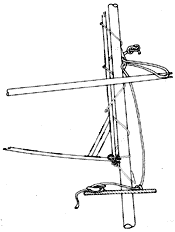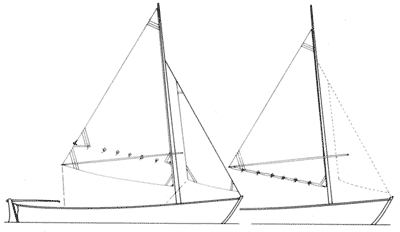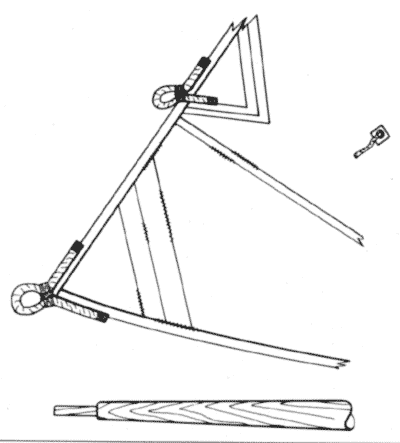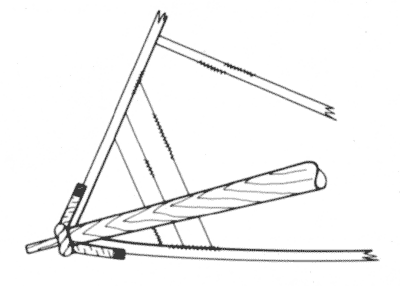Sprit Booms
by Chris Wentz
(Excerpted from "Small Boat Journal" - May, 1984)
Basically undesirable things, booms
spent some time in the sailing public's eye before that public
adopted them for general use. No doubt even more time will pass
before we remove them from applications that do not need them.
And in spite of what history has taught us, we do not entirely
understand booms.
A boom is supposed to be a great
help when you sail a boat off the wind. To some extent, it is,
but unless you have a means of controlling the way the boom hikes
up when the boat runs before a breeze, it is not so helpful. When
the foot of the sail lifts, the entire sail twists. Those nervous
rolls to windward that keep your heart in your mouth as you sail
downwind in a breeze are the result.
 click to enlarge image
click to enlarge image |
The correct way to lace the luff
is shown. Don't combine this lace line with the head or
tack lashing.
This type of snotter
attachment to the mast combines a dead end and a fairlead.
It's tapered so the lace line will pass over when the sail
is hoisted or lowered.
A jaw in the forward
end of the sprit is simple & good for smaller sails,
say up to 100 sq. ft. above that blocks rather than dead
eyes will help keep things easy.
A thumb cleat is
good for the tack lashing. Two half hitches keeps things
secure. The snotter can pass thru a bulls eye and go on
to a "V" jam cleat. No moving parts herel |
Twist, in this context, simply
means that the top and bottom of the sail are trimmed to a very
different extent because you have little choice but to trim the
major part, or bottom, of the sail and let the top twist off.
This overeased section causes rolling. To test this out, next
time your boat sets up a rhythmic roll or rolls upon acceleration
in a puff, rapidly trim the mainsheet and she'll settle right
down. She'll also slow down because most of the sail area is over-trimmed.
A boom vang — or saltier
and more correctly, a boom jack or kicking strap — is one
solution to the problem of twist. The vang simply pulls down on
the boom when it is eased too far outboard for the sheet to perform
this function. Pulling downward sets the leech of the sail and
allows you to choose the amount of twist that you want.

| If she's a sloop, the jib leech
must clear the sprit. The mainsheet should lead more
or less straight down. If there is a conflict with
the tiller, a rope 'horse' can be used. |
First reef: strike the jib. Second
reef: shorten the main |
|
I'm not suggesting that you put
a boom vang on your traditional boat. It might look out of place,
and traditionally proportioned spars are not shaped to withstand
a bending strain in the middle. There is, however, one terrific
way to get the advantages of a boom and avoid the pitfalls —
equip your boat with a sprit boom
Scarce and generally misunderstood,
the sprit boom is the closest thing to a panacea for a boomed
rig. It requires no gooseneck, no outhaul to control the shape
of the sail, and because it is only under compression,
it can be much lighter than a conventional boom. The sprit boom
is both boom and vang; the portion of the sail below the sprit
prevents the sail from hiking up when you ease the sheet. The
result is an untwisted sail on the wind or off. Forcing the sprit
aft not only flattens the sail, it tensions the foot and the leech.
Therefore, the biggest job of the mainsheet, that of tensioning
the leech, is removed. The sheet, then, has only to trim the boom
athwartships. Relieving the burden allows you to play the mainsheet
in a breeze without help from a multi-part purchase.
| Finish the clew with a becket. A strong
seizing closes the loop. Any reef should be finished
the same way. |


|
| The end of the sprit should be whittled
down so there is a 1/4" shoulder |
| This type of sprit to sail attachment
is simple, reliable, and causes very little distortion
in the sail. |
|
The modern variant of the sprit
boom is the wishbone boom. It performs the same tasks as does
the sprit boom, but it interferes with the sail a lot less. It
might be the ultimate boom if it didn't take up so much space
in the boat when the rig is struck. You must place the wishbone
before you step the mast, and it's very much in the way when you
go forward to raise your stick.
If the clew of your sail is so
far aft that sheeting is a problem, a sprit boom may be the answer.
It needs no horse (traveler) and may be the only arrangement for
a double-ender. A block right on the center line is all you need.
You can place it on the rudderhead.
I can't claim to be open-minded
about sprit booms; I'm sold on them.
|

